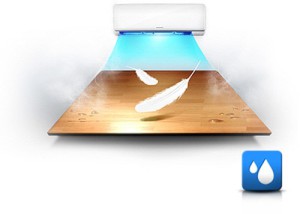Any air conditioner reduces air humidity. But only air conditioners with drainage can fully regulate this process.
Does the drainer need air conditioning?
 For the human body, humidity in the range of 40 to 60% is comfortable. In wet weather (and in some regions and constantly) humidity reaches 90%. In such an atmosphere, not only people feel bad: fungi and mold bloom in the corners of the rooms. The apartment or office has a heavy spirit of mustiness, things and bedding are damp and unpleasant. Residents of old houses, as well as houses with a disturbed ventilation system, are very affected by high humidity.
For the human body, humidity in the range of 40 to 60% is comfortable. In wet weather (and in some regions and constantly) humidity reaches 90%. In such an atmosphere, not only people feel bad: fungi and mold bloom in the corners of the rooms. The apartment or office has a heavy spirit of mustiness, things and bedding are damp and unpleasant. Residents of old houses, as well as houses with a disturbed ventilation system, are very affected by high humidity.
An air conditioner with dehumidification keeps humidity precisely within the optimal parameters. Not drying the air (too dry is harmful to the skin and respiratory organs), but also not allowing humidity to increase.
The dehumidification mode of the air conditioner allows you to simply dry the air without cooling or warming it. And this is the main feature of this technique.
How does the drain mode work?
The principle of operation of the drainage mode of the air conditioner is simple. Warm air enters the ice heat exchanger (Freon in it). In the process of heat transfer, water from the air condenses on cold surfaces. Moisture accumulates in a special tank and is discharged outside the premises through a drainage system. This is how any air conditioner works.
But the principle of air drying with an air conditioner with a special function is somewhat more complicated. However, the best models cope with this task by changing the temperature by less than 10 degrees.
This is achieved by special modes of operation. The equipment starts in cold mode. As soon as the heat exchanger cools as much as possible, the fan blades go to low revs. The heat exchanger is blown very slowly. As a result, the water condenses, but the air temperature remains at the initial level. Sometimes the fan stops altogether.
Nevertheless, cold air still enters the room. Therefore, manufacturers go to a wide variety of tricks to reduce this effect. For example, heat exchangers are equipped with a special type of valves that block the access of the refrigerant to the lower part. Thus, one part of the heat exchanger is cooled and the air conditioner dries the air, after which it enters the warm part and its temperature is restored.
Only models of climatic equipment from the best manufacturers are provided with a dehumidification mode (Daikin, Panasonic, Mitsubish Electric and others).


